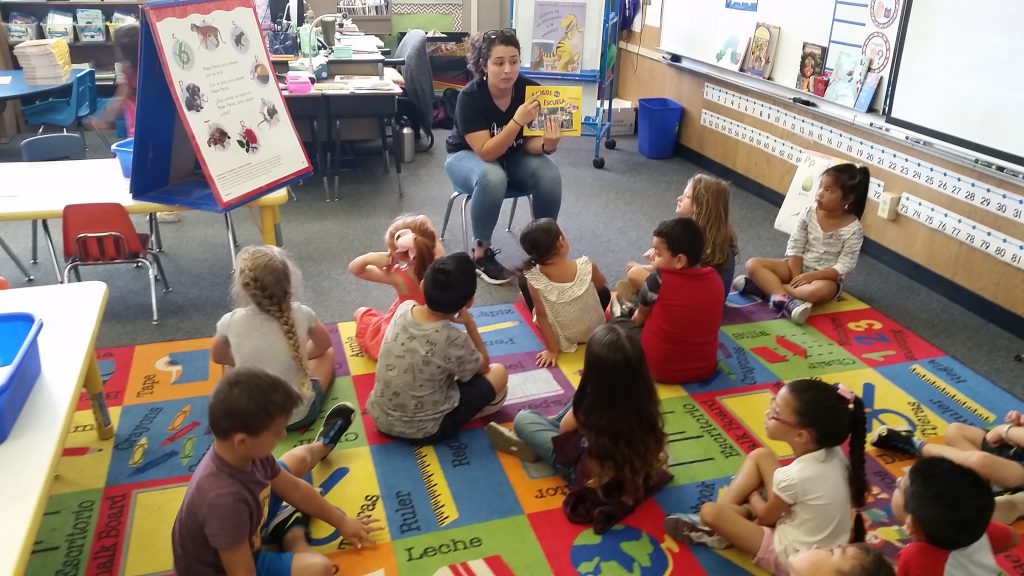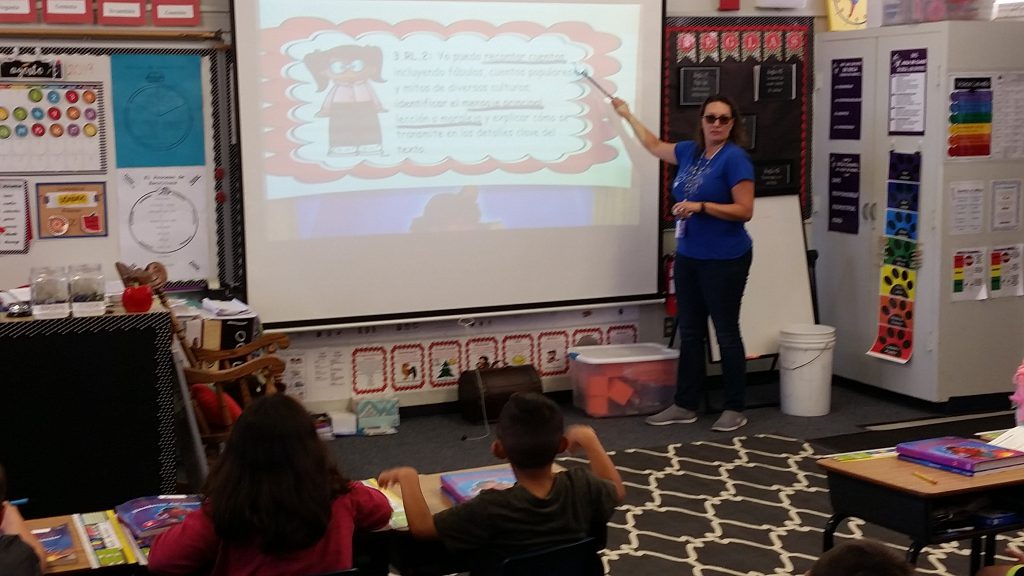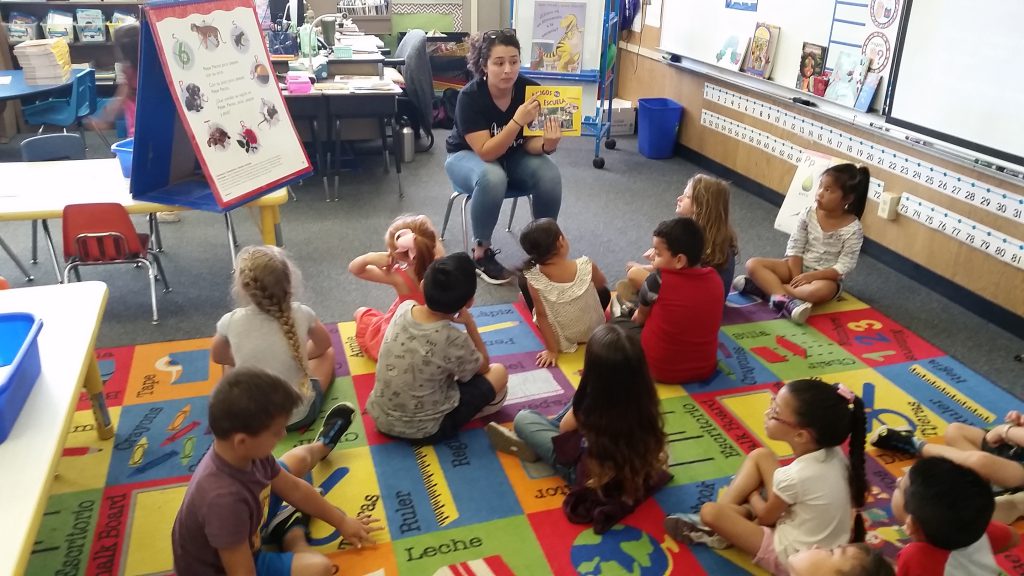
One of the primary goals at Denair Elementary Charter Academy is to provide a learning environment with a multicultural emphasis. Exposing students to Spanish is a key component of that, both in the traditional program as well as the Dual Language Immersion (DLI) program.
Of DECA’s 576 students in kindergarten through fifth grade, 409 are enrolled in the traditional program. That means they receive 30 minutes of Spanish instruction up to three times a week. The 167 children in the DLI program are taught in a mixture of English and Spanish, depending on the grade level.
“DECA’s Dual Language program has been well-designed and is well-supported. It is also an integral part of the broader course of study at DECA,” said Denair Superintendent Terry Metzger. “Students in our English-only classes also participate in many of the activities, assemblies, and learning opportunities provided through the Dual Language program. All students benefit, whether they are in a Dual Language or English-only classroom.”
All DECA students also are part of the Positive Behavior Intervention and Supports (PBIS) program, which includes schoolwide rules and behavior expectations. Students are rewarded in various ways for helping to create a positive school culture and modeling positive behavior.
Another thing that sets DECA apart is its focus on promoting college attendance, even at the lowest grade levels. Each classroom adopts a college. Students are taught about different universities and what going to college means.
The children in the traditional and DLI programs share time on the playground, in the cafeteria and at schoolwide events.
It’s what happens in their classrooms that separate the traditional and DLI students.
In DLI classes, instruction in English and Spanish is precisely calculated. Starting in kindergarten, 90% of instruction is done in Spanish and 10% in English. That ratio adjusts by 10% each year until by the fourth grade, each language is used half the time.
DLI students are almost equally divided between those who speak English at home and those who speak Spanish. Even so, Spanish is emphasized in the younger grade levels.
In kindergarten through second grade, teachers only can speak Spanish to students inside and outside of class – whether it’s on campus or they meet in the community outside school hours. Even at the pick-up and drop-off where parents or family members are present who only speak English.
“We don’t let them ‘code switch,’ ” explained Principal Kelly Beard. “Even if I was to walk into class and ask the teacher a question in English – because I don’t speak Spanish – she will respond in Spanish.”
The goal, Beard says, is to create students who are bilingual and biliterate, who can read, write and speak in both languages. It happens at different rates for each student, but typically, most children understand both languages by third grade.
“Some of those students who have stronger first language skills will grasp the second language faster, but it varies,” said Learning Director Laura Cardenas, who is bilingual.
Becoming bilingual happens in stages, Cardenas explained:
- Silent/receptive: This stage may last from several hours to several months. During this time, new language learners typically spend time learning vocabulary and practice pronouncing new words. While they may engage in self-talk, they don’t normally speak the language with any fluency or real understanding.
- Early production: This stage, learners typically acquire an understanding of up to 1,000 words. They may also learn to speak some words and begin forming short phrases, even though they may not be grammatically correct.
- Speech emergence: By this stage, students learn to communicate by putting the words in short phrases, sentences and questions. Again, they may not be grammatically correct. During this stage, learners gain greater comprehension and begin reading and writing in their second language.
- Intermediate fluency: At this stage, learners typically have a vocabulary of about 6,000 words. They usually acquire the ability to communicate in complex sentences. In this stage, learners begin actually thinking in their second language, which helps them gain more proficiency in speaking it.
- Continued language development/advanced fluency: It takes most learners at least two years to reach this stage, and then up to 10 years to achieve full mastery of the second language. Second-language learners need ongoing opportunities in discussions and expression in their new language.
One way to gauge progression, Cardenas said, is when students begin to recognize and use words (known as “cognates”) that are similar in English and Spanish. Some examples are “sum” and “sumar,” “elevate” and “elevar,” “contrast” and “contraste,” “observe” and “observer,” and “experiment” and “experimentar.”
“I try to focus on cognates,” said third-grade DLI teacher Nicole Janz. “I also focus on context clues. Even if you don’t know a word, can you think how it might be used in a sentence?”
Parents who speak only one language at home often ask how they can support their children in the second language.
Textbooks can be sent home in both languages, Beard said, so parents can understand lessons. She also encourages parents to have English and Spanish dictionaries or use online tools like Google Translate. Reading to children in any language always is positive. And applauding their child’s efforts to learn a second language and emphasizing its importance is a key.
“If parents have any questions, we always suggest reaching out to their child’s teacher,” Beard said.
Metzger said research shows that there are many social and cognitive benefits to being bilingual.
“For example, those who are bilingual tend to have better executive function (how your brain organizes information) and better task-switching abilities,” she said. “DECA’s program also includes attention to multiculturalism, which builds understanding and acceptance of diversity.”
With the first group of DLI students in fourth grade this year, plans already are being made for how the program will look when those children enter Denair Middle School in two years. Metzger said an informational meeting for interested parents and teachers will be scheduled in early October. “As far as preparing students,” she said, “the key is to build as much academic fluency between the two languages as possible, because at least one of the students’ core academic classes (science, history or math) will be in Spanish.”


